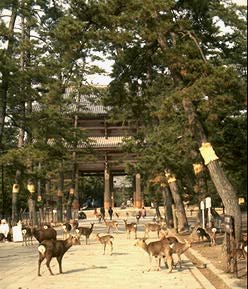
In the sixth and seventh centuries, Yamato aristocrats constructed many Buddhist temples. For example, traditional accounts claim that Horyūji was built in the late sixth century by the order of Prince Shōtoku, who is also credited--probably incorrectly--with founding many other temples and introducing important Buddhist texts into Japan. Other temples were built in provincial locations by local notables. When a capital city was constructed at present-day Nara in the eighth century, moreoever, a healthy portion of its buildings were Buddhist temples. The Emperor Shōmu, who recognized Buddhism's political potential as a symbolic support for political centralization, sponsored the construction of Tōdaiji in Nara and subsidiary temples in each province. Strong ties between Buddhism and the government developed: the ordination of monks and nuns was controlled by the court, and temples were supported by taxes, by labor from designated households, and by lands donated by the government along with special tax considerations.

|
Deer roam freely along the path leading to Tōdaiji in Nara. |
The temples at Nara are often characterized as scholarly institutions that housed the study of abstruse texts and philosophical doctrines. But it is not clear how much scholarship was actually undertaken in a society in which basic literacy was still quite limited, even among the ruling elite. The emphasis of Nara Buddhism was, rather, on rituals to ensure the prosperity of the state and the health and welfare of its rulers. Many small images from this period, inscribed with prayers for the cure of a noble's illness, attest to this emphasis.
Go back to previous section.
 Go on
to next section.
Go on
to next section.
Return to menu page.